What are the different types of cryptocurrencies? Understanding token types
Discover the different types of cryptocurrency, including Bitcoin, stablecoins, and NFTs, along with their key features and real-world applications.
By Corey Barchat

In just over a decade, blockchain technology and cryptocurrency have revolutionized the way we think about money, finance, and digital ownership. Since the launch of Bitcoin in 2009, the crypto landscape has expanded dramatically, boasting a total market capitalization of over $2 trillion.
Though Bitcoin is the most widely-known cryptocurrency, it is far from the only one. Similar to other assets, these diverse digital assets can be categorized based on their purpose, functionality, and underlying technology. The different types of cryptocurrencies range from purposes that include decentralized finance (DeFi), digital collectibles, international remittances, security, privacy, voting, and much more.
Whether you're interested in making payments, or participating in a new financial system, there's bound to be a cryptocurrency that fits your needs.
In this article, we will explore the main types of cryptocurrencies, their examples, and the use cases that make them valuable in today's digital economy.
The main types of cryptocurrencies
From Aave to Zcash, there are crypto tokens for many different use cases in the world of Web3. Here are a few of the most common types.
A table of the different types of cryptocurrency
Payment cryptocurrencies
Payment cryptocurrencies are perhaps the most straightforward and widely recognized type of cryptocurrency. Different from more specialized tokens (which we will see below), they are designed primarily as digital currencies for making payments, transferring value, and facilitating transactions over the internet.
Payment tokens aim to provide an alternative to traditional fiat currencies by offering faster, cheaper, and more secure transactions.
Most payment cryptocurrencies operate on decentralized networks, meaning they can function without a central authority. This decentralization allows for direct peer-to-peer transactions, reducing the need for intermediaries and helping to lower transaction fees.
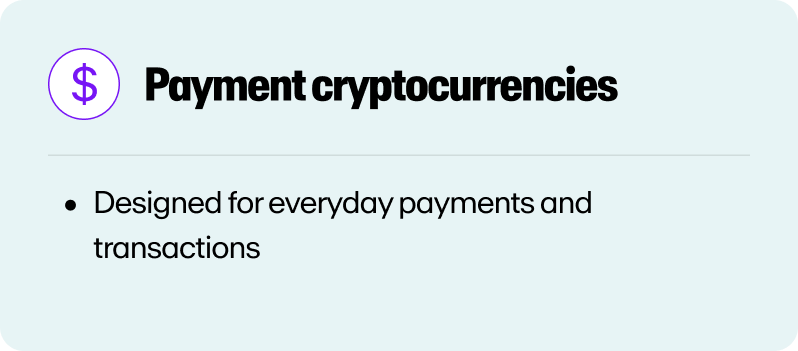
Examples of payment tokens
- Bitcoin (BTC): The first cryptocurrency and the top token by price and market cap, Bitcoin was created by an anonymous person or group known as Satoshi Nakamoto. BTC primarily serves as a decentralized digital currency that can be used for payments, transfers, and remittances.
- Litecoin (LTC): Sometimes referred to as the "silver to Bitcoin's gold," Litecoin was created by Charlie Lee in 2011. LTC offers faster transaction times and a different hashing algorithm, in an attempt to be more accessible for everyday transactions than Bitcoin.
- Dash (DASH): Originally known as Darkcoin, Dash focuses on providing fast and low-cost transactions with enhanced user privacy. It includes features like InstantSend and PrivateSend, which enhance its functionality as a payment cryptocurrency.
Payment token use cases
- Everyday transactions: Payment cryptocurrencies like Bitcoin, Bitcoin Cash, and Litecoin can be used for everyday purchases at participating merchants, from buying coffee to paying for online services.
- Cross-border payments: These cryptocurrencies can be particularly useful for international remittances, with reduced fees and processing times compared to traditional money transfer services.
- "HODL": Bitcoin is often viewed as a "digital gold" due to its scarcity and deflationary nature, leading many users to simply "HODL" or hold BTC. However, BTC's volatility has thrown into doubt its status as a store of value or hedge against inflation.
Stablecoins
Stablecoins were created to minimize volatility and price fluctuations via pegging to a stable asset, such as a fiat currency like the US dollar, or a commodity like gold. The primary goal of stablecoins is to provide the benefits of cryptocurrencies—such as security, speed, and transparency—while avoiding the extreme price swings that are common in the cryptocurrency market.
Stablecoins attempt to achieve their stability through various mechanisms, including backing by reserves, algorithmic control of supply, or a combination of both. Though they aim to maintain price stability, fluctuations and de-pegging have been known to occur, even for the most widely-traded stablecoins.

Examples of stablecoins
- Tether (USDT): Tether is the stablecoin with the highest market cap, and is pegged 1:1 to the US dollar. USDT is backed by reserves held by Tether Limited, in an attempt to provide users with a stable digital currency for trading and transfers.
- USD Coin (USDC): USD Coin is the second-leading stablecoin by market cap, pegged to the US dollar and backed by reserves. It is issued by Circle and Coinbase, though it was originally issued by the Centre Consortium.
- Dai (DAI): Dai is a decentralized stablecoin created by the MakerDAO protocol. Unlike USDT and USDC, DAI is not backed by fiat reserves but is instead collateralized by other cryptocurrencies, making it a unique stablecoin example.
Stablecoin use cases
- Reducing volatility: Users can trade stablecoins like USDT and USDC to hedge against market volatility, allowing them to move funds into a stable asset without exiting the crypto market.
- Secure transfers: Stablecoins provide a secure way to hold and transfer money, particularly in regions with unstable local currencies or limited access to banking services.
- Cross-border payments: Stablecoins enable fast and cost-effective cross-border payments, offering a more stable alternative to crypto remittances.
Utility tokens
Utility tokens provide holders with access to specific products or services in a blockchain platform. Unlike payment cryptocurrencies, utility tokens are not primarily designed as a means of exchange but serve a unique purpose within a particular ecosystem.
These tokens extend beyond simple payments and play a crucial role in decentralized applications (dApps), like for paying transaction fees, accessing premium features, or participating in governance decisions.
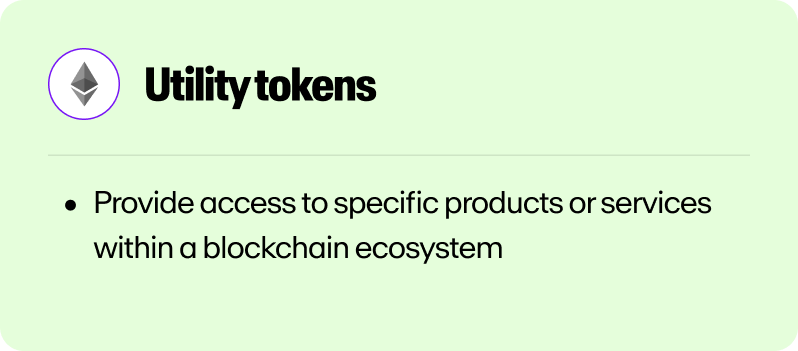
Examples of utility tokens
- Ethereum (ETH): Ethereum's native token, Ether (ETH), is used to pay for transaction (gas) fees and computational services on the Ethereum network. It is also used to interact with smart contracts and decentralized applications.
- Basic Attention Token (BAT): BAT serves as a utility token within the Brave browser ecosystem, enabling users to reward content creators and receive incentives for viewing privacy-respecting ads.
- Chainlink (LINK): LINK is the native token of the Chainlink network, which provides decentralized oracle services. Specifically, Chainlink tokens are used to pay for data retrieval and other services provided by Chainlink nodes.
Utility token use cases
- Decentralized applications (dApps): Utility tokens like ETH and other ERC-20 tokens are essential for interacting with DeFi protocols, as they are used to pay for transactions and services within these applications.
- Payment for services: Utility tokens can be used to pay for services such as data storage, computational power, or access to specific features within a blockchain network.
- Governance and voting: Some utility tokens grant holders the right to vote on network upgrades, protocol changes, and other governance decisions, giving them a say in the future development of the project. However, not all utility tokens are governance tokens, as we will see below.
Security tokens
Security tokens, or tokenized securities, are a type of cryptocurrency that represents ownership in an underlying asset, such as a company, real estate, or investment fund. These tokens are similar to traditional securities, like stocks or bonds, but are issued and managed on a blockchain.
The primary advantage of security tokens is the ability to tokenize assets that were previously illiquid, such as real estate or private equity, making them more accessible to a broader range of investors. Security tokens also enable fractional ownership, allowing investors to purchase a small portion of a higher-value asset.
Just like their non-crypto counterpart, security tokens may be subject to securities regulations, which generally provide investors with certain protections and rights. However, these regulations vary by country or region, so users should check with local guidelines before interacting with these tokens.
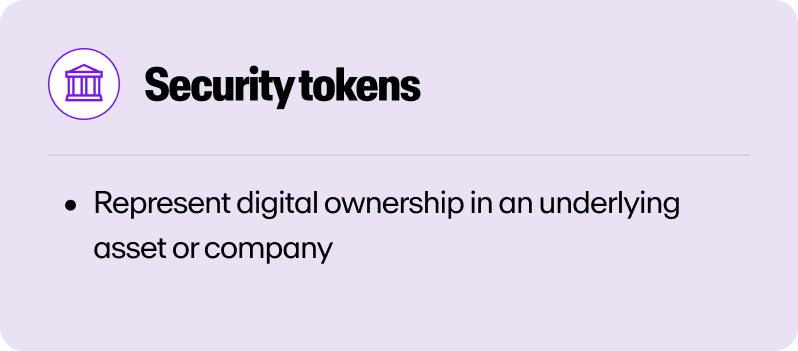
Examples of security tokens
- tZERO (TZROP): tZERO is a blockchain-based trading platform that offers security tokens, including its own TZROP token, which represents equity in the company.
- INX (INX): INX is a security token issued by the INX trading platform, representing ownership in the company and entitling holders to a share of the platform's profits.
- Siafunds (SIA): Siafunds are security tokens issued by the Sia blockchain, representing a share in the revenue generated by the Sia decentralized cloud storage network.
Security token use cases
- Digital asset ownership: Security tokens enable the issuance and trading of digital securities, providing investors with ownership stakes in various assets.
- Investment opportunities: Security tokens open up new investment opportunities, particularly in traditionally illiquid assets, by making them more accessible and easier to trade.
- Dividend distribution: Security tokens can be programmed to automatically distribute dividends or revenue shares to token holders, streamlining the process for both issuers and investors.
Governance tokens
Governance tokens grant holders the right to participate in the decision-making processes of a blockchain network or decentralized protocol. These tokens enable holders to vote on important decisions, such as protocol upgrades, changes to the network's parameters, or the allocation of funds from a treasury.
Governance tokens are a critical component of decentralized autonomous organizations (DAOs), where decision-making power is distributed among the community and weighted by the number of tokens held. This decentralized governance model helps the network to evolve in a way that reflects the interests of its community.
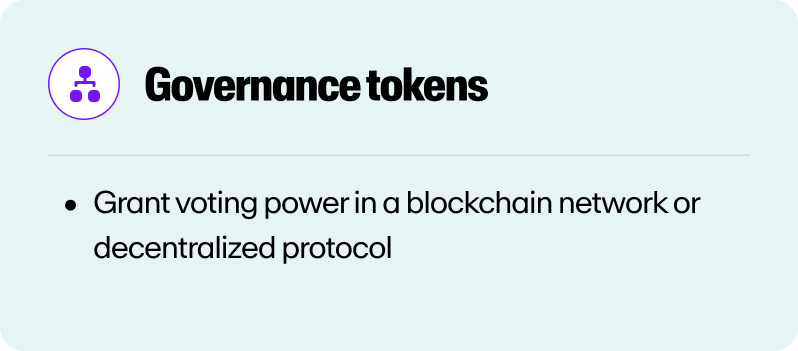
Examples of governance tokens
- Uniswap (UNI): UNI is the governance token of the Uniswap decentralized exchange, allowing holders to vote on protocol upgrades and changes to the platform's fee structure.
- Compound (COMP): COMP is the governance token for the Compound protocol, a decentralized lending platform. COMP holders can vote on changes to the protocol's parameters, such as interest rates and collateral requirements.
- Maker (MKR): MKR is the governance token for the MakerDAO protocol, which manages the Dai (DAI) stablecoin. MKR holders can vote on changes to the protocol, including the types of collateral that can be used to generate DAI.
Governance token use cases
- Voting on upgrades and proposals: Governance tokens give holders a voice in the development of the network, allowing them to vote on technical upgrades, policy changes, and other critical decisions.
- Influence over development: By holding governance tokens, users can influence the direction of a project to align with their interests and values.
- Participation in DAOs: Governance tokens are often used to facilitate decision-making in decentralized autonomous organizations, where community members collectively manage the organization and its resources.
Privacy coins
Privacy coins are a type of cryptocurrency designed to provide enhanced privacy and anonymity for users. Unlike most other cryptocurrencies, which operate on transparent blockchains, privacy coins use advanced cryptographic techniques to obscure transaction details, such as the sender, receiver, and amount.
Privacy coins are particularly appealing to individuals who prioritize financial privacy, whether to protect against surveillance, avoid censorship, or simply keep their financial activities confidential. However, they have also attracted scrutiny from regulators due to concerns about their potential use in illicit activities.
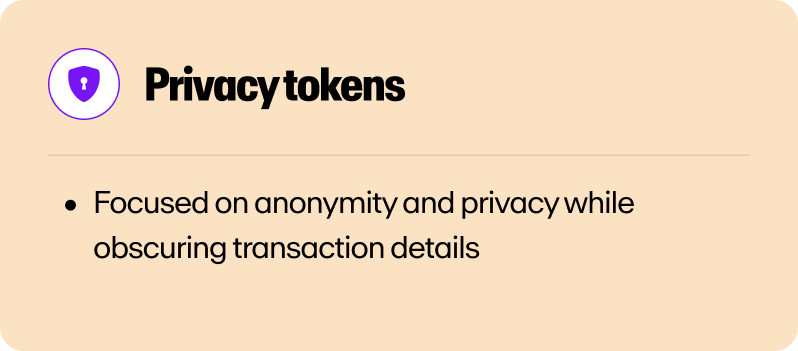
Examples of privacy tokens
- Monero (XMR): Monero is one of the most widely-used privacy coins, using technologies like ring signatures, stealth addresses, and confidential transactions to enhance privacy for its users.
- Zcash (ZEC): Zcash offers optional privacy features through its "shielded" transactions, which use zero-knowledge (zK) proofs to protect transaction details while still allowing for transparency when needed.
- Dash (DASH): Dash includes an optional privacy feature called PrivateSend, which mixes transactions to obscure the origin and destination of funds, providing an additional layer of anonymity when sending and receiving crypto assets.
Privacy coin use cases
- Private transactions: Privacy coins are commonly used by individuals who want to conduct transactions without exposing their financial details to the public.
- Enhanced security: By obscuring transaction details, privacy coins provide enhanced security against hacking, identity theft, and other forms of financial exploitation.
- Surveillance protection: Privacy coins offer greater protection against surveillance and censorship, allowing users to maintain control over their financial privacy.
Non-fungible tokens (NFTs)
NFTs (non-fungible tokens) represent ownership of unique digital assets. Unlike typical cryptocurrencies that are fungible and can be swapped equally, NFTs are unique and cannot be exchanged like-for-like. This uniqueness makes NFTs ideal for representing digital art, collectibles, virtual real estate, and other items where individuality and scarcity are essential.
NFTs are typically created and managed on blockchain platforms like Ethereum, using token standards such as ERC-721 or ERC-1155. The ownership and transfer of NFTs are recorded on the blockchain, providing a transparent and immutable record of who owns each digital asset.
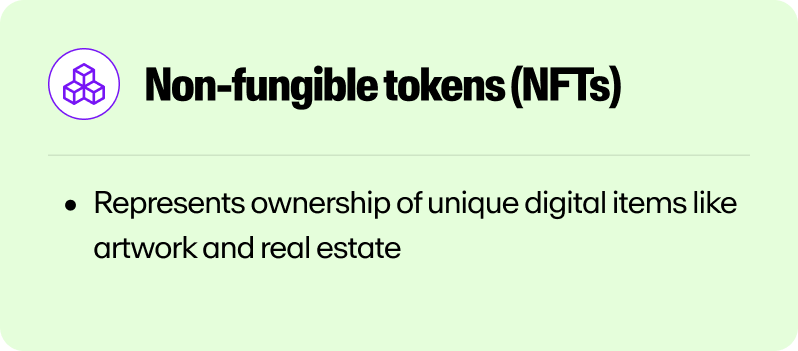
Examples of non-fungible tokens (NFTs)
- CryptoPunks: CryptoPunks are one of the earliest examples of NFTs, featuring 10,000 unique 24x24 pixel art characters on the Ethereum blockchain. They have become highly sought-after digital collectibles, with generally few listings due to their scarcity and status among the NFT community.
- Gods Unchained: Gods Unchained is a digital trading card game, where each card is an NFT that players can collect, trade, and use to battle. The game emphasizes true ownership of digital assets, allowing players to trade and sell their cards on secondary marketplaces.
- Decentraland (MANA): Decentraland is a virtual world where users can buy, sell, and trade virtual land and assets. Decentraland is powered by the MANA token, which can be used to purchase in-game assets like LAND ERC-721 tokens.
NFT use cases
- Digital collectibles: NFTs are widely used to represent ownership of digital art and collectibles, allowing artists and creators to monetize their work in the digital space.
- Virtual real estate: In virtual worlds like Decentraland and the Sandbox, NFTs are used to represent ownership of virtual land and property, enabling users to build, trade, and monetize virtual assets.
- Gaming assets: NFTs are increasingly being used in gaming to represent unique in-game items, such as weapons, characters, and skins, which can be bought, sold, and traded by players.
Exchange tokens
Exchange tokens are a type of cryptocurrency issued by crypto exchanges to provide various benefits to their users. These tokens generally offer benefits like reduced trading fees, access to exclusive promotions, and other perks for holders. Exchange tokens can also play a role in governance, allowing users to vote on decisions that affect the platform and its future.
Exchange tokens are typically used within the ecosystem of the issuing crypto exchange, but they can also be traded on other platforms. They have become a way for certain cryptocurrency exchanges to build loyalty among their users and incentivize participation in their services.
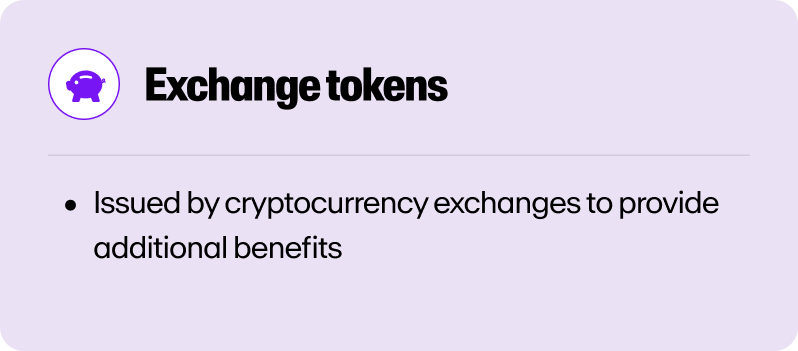
Examples of exchange tokens
- Binance Coin (BNB): Binance Coin is the native token of the Binance exchange, also functioning as a utility token used to pay for (reduced) trading fees, and access services on the platform like the Binance Launchpad.
- Uniswap (UNI): While primarily a governance token, UNI is a token associated with the Uniswap DEX. As an incentive, users that previously engaged with the DEX were rewarded with a surprise airdrop of more UNI tokens in 2020.
- KuCoin Token (KCS): KCS is the native token of the KuCoin exchange, providing holders with reduced trading fees, profit-sharing, and access to exclusive promotions.
Exchange token use cases
- Reduced trading fees: Exchange tokens often provide holders with discounts on trading fees, making them a cost-effective option for frequent traders.
- Exchange promotions: Exchange tokens can be used to participate in exclusive promotions on crypto exchanges, such as token sales, staking programs, and reward schemes like airdrops.
- Governance rights: Some exchange tokens grant holders governance rights, allowing them to vote on platform upgrades, new listings, and other important decisions.
Other emerging types of cryptocurrencies
Since cryptocurrency and blockchain technology are still in their relatively early stages, they are constantly evolving. As new digital assets emerge, they introduce new features, use cases, and market dynamics that reshape the crypto landscape.
Yield farming tokens
Yield farming tokens are a type of cryptocurrency used to incentivize liquidity provision in decentralized finance (DeFi). Yield farming involves lending or staking assets in DeFi protocols to earn rewards in the form of tokens. These tokens can be traded, reinvested, or used to participate in governance decisions within the DeFi ecosystem.
Yield farming tokens have become popular due to the high returns they can offer, but they also come with significant risks, including price volatility, smart contract vulnerabilities, and impermanent loss.
Meme coins
Meme coins are a category of cryptocurrency that started as internet jokes or memes but have gained significant popularity. They are often driven by community sentiment, social media hype, and celebrity endorsements, making them highly volatile and speculative investments.

Perhaps the most famous example of a meme coin is Dogecoin, which was created as a parody of Bitcoin, but has since developed a growing and enthusiastic community. Shiba Inu is another example, sometimes referred to as the "Dogecoin killer," which has also seen price surges (as well as its share of downturns).
Algorithmic stablecoins
Algorithmic stablecoins are a type of stablecoin that uses algorithms and smart contracts to maintain their peg to a stable asset, rather than being backed by reserves. These stablecoins adjust their supply in response to changes in demand to keep their price stable.
While they offer an innovative approach to stability, algorithmic stablecoins like Terra's UST token have faced challenges in maintaining their pegs, leading to concerns about the asset class' long-term viability.
Synthetic assets
Synthetic assets are a type of cryptocurrency that represents the value of real-world assets, such as stocks, commodities, or fiat currencies, within the DeFi ecosystem. These assets are created using smart contracts and can be traded on decentralized exchanges.
Synthetic assets allow users to gain exposure to traditional financial markets without needing to hold the underlying assets. Examples of synthetic assets in DeFi include sUSD (a synthetic dollar) and sBTC (a synthetic Bitcoin), which are part of the Synthetix protocol.
Dive into the world of crypto
Now that you've learned about the different types of cryptocurrency, it's time to experience them firsthand.
MoonPay offers a fast and easy way to buy crypto using a credit card, debit card, Apple Pay, or bank transfer. When you decide it's time to exit, you can sell crypto via MoonPay's simple off-ramp, or swap tokens for other crypto assets.
You can also get started by simply loading your wallet with euros, pounds, or dollars and using your MoonPay Balance to purchase Bitcoin (BTC), Ethereum (ETH), and more. Use MoonPay Balance for faster, cheaper transactions and improved approval rates. When you're ready to withdraw, enjoy zero fees and direct transfers to your bank account.



.png)


